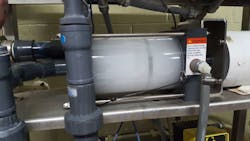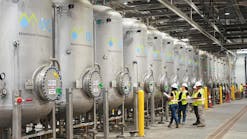Two-Zone polymer activation system saves city of Fort Atkinson over 25% on polymer expense
WISCONSIN -- Fort Atkinson is a city located in southeastern Wisconsin with a population of about 13,000 people. The original wastewater treatment plant (WWTP) was built in 1972. At that time, it was a conventional activated sludge design and has since been upgraded a several times, in the 1980’s and 1990’s with additional processes including aerobic digestion, sludge storage and centrifuge dewatering.
As with many WWTPs, a large portion of the treatment plant’s operating budget is spent on polymer, primarily to dewater aerobically digested sludge. At Fort Atkinson, the sludge typically has a 2% solids concentration and is dewatered via a centrifuge. The plant had an existing polymer system that consisted of a polymer tote, transfer pump, static mixer, aging tank and progressive cavity metering pump. The system was effective, but the operators sensed it required too much polymer and started to investigate efficiency opportunities. In August of 2019, Paul Christensen, Utility Manager, Erin Sweeney, Maintenance Supervisor, and Ryan Wagner, Plant Operator were looking for a way to optimize their polymer system and lower costs. UGSI Chemical Feed, Inc. of Vineland, NJ, working with their local Wisconsin representative, Energenecs offered a free demonstration of the Polyblend®-Magnum skid mounted polymer system.
The City agreed to the free-demonstration and began using the Polyblend M-Series in November 2019. The Polyblend® system was able to decrease polymer usage by 25-30% as compared to the original polymer activation system and enabled the dewatering equipment to operate more efficiently. Previously, the plant averaged about 35 gallons of emulsion polymer usage per day with the previous system. The Polyblend® Magnum system averaged about 25 gallons per day – approximately 30% in polymer savings. The City projects an annual savings of $20,000 which is above the goal they had hoped to achieve. An added benefit was that staff found the system to be much more space efficient versus the older mix-tank system.
Based on overall performance, the City decided to purchase the Polyblend® system in December 2019. Erin, Ryan and Paul recently said, “It was a no brainer. We are so happy we changed our polymer system to the Polyblend® Magnum system. It has really done the job for us and has saved the City so much in operating costs, specifically polymer”.





